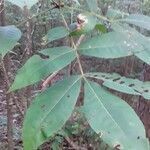Trees , to 41 m. Bark light gray, fissured or exfoliating, separating freely into large, thick, broad plates that persist. Twigs orange-tan, stout, hirsute, scaly. Terminal buds tan, broadly ovoid with apices of outer scales prolonged, 12-20 mm, tomentose; bud scales imbricate; axillary buds protected by bracteoles fused into hood. Leaves 6-9 dm; petiole 6-13 cm, minutely hirsute, becoming glabrous at base. Leaflets (5-)7-9(-11), lateral petiolules 0-1 mm, terminal petiolules 2-14 mm; blades ovate to obovate or elliptic, not falcate, 9-20 × 3-10 cm, margins coarsely serrate, apex narrowly acuminate; surfaces abaxially hirsute with unicellular, 2-6-rayed fasciculate and occasionally multiradiate hairs, scaly with abundant large peltate scales and small round peltate scales, adaxially hirsute along midrib, puberulent throughout. Staminate catkins pedunculate, to 20 cm, stalks and bracts minutely hirsute, capitate-glandular; anthers hirsute. Fruits tan to brown, spheric to ellipsoid, not compressed or slightly so, 4.5-6 × 4-5 cm; husks minutely hirsute, 7-13 mm thick, dehiscing to base, sutures smooth; nuts tan, ellipsoid, compressed, 4-angled, rugulose; shells thick. Seeds sweet.
More
A medium sized tree. It grows to 30 m high. The trunk can be 90 cm across. The trunk does not have branches for more than half its length. The trunk often tapers from the base up. The crown is often open with branches spreading out towards the top. The bark peels in 1 m long curving plates. The leaves have 7 or sometimes 9 leaflets. The leaves are 25-30 cm long. The leaflets are widest near the middle. The upper surface is dark yellowish-green. They are paler and hairy underneath. The central leaf stalk often remains after the leaflets have fallen. The male and female flowers are separate. The male or pollen flowers are in dense clusters of catkins. They occur at the base of new shoots. The female or seed flowers are in small clusters at the tips of new shoots. The fruit are almost round and 5-7 cm long. The husks are 6-12 mm thick and woody. They split along 4 lines to the base when ripe. The nuts have thicker shells with poorer cracking quality than Shagbark hickory. The kernels are sweet and edible.


